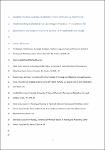Student nurses as a future General Practice Nursing workforce. Implementing Collaborative Learning in Practice: implications for placement learning and patient access. A mixed methods study.
| dc.contributor.author | Williamson, G | |
| dc.date.accessioned | 2023-09-18T08:27:08Z | |
| dc.date.available | 2023-09-18T08:27:08Z | |
| dc.date.issued | 2023-09-21 | |
| dc.identifier.issn | 1472-6955 | |
| dc.identifier.issn | 1472-6955 | |
| dc.identifier.other | 326 | |
| dc.identifier.uri | https://pearl.plymouth.ac.uk/handle/10026.1/21329 | |
| dc.description.abstract |
Background There is a global shortage of nurses, with particularly acute shortfall in General Practice Nursing in the United Kingdom estimated at as high as 50% vacancy rate by 2031 by some sources. There has previously been reluctance for General Practices to host student nurses on placement, but it has become imperative to increase placement capacity if practices are to be able to recruit a future workforce. Collaborative Learning in Practice is a means of organising placement learning for student nurses using a coaching model, that allows for leadership development, peer support and earlier engagement in patient care, and increases placement capacity. Methods This was a mixed methods study using qualitative data from focus groups to evaluate the implementation of Collaborative Learning in Practice, and routinely collected audit data on numbers of clinic appointments to investigate the potential impact an increased capacity of student nurses might have on patient access to services. The aims of this study were: to implement and evaluate Collaborative Learning in Practice in General Practice Nursing settings; to explore issues of interprofessional learning; to explore patient access to services related to increased student nurse capacity. Results Our qualitative data indicated the following themes as important to students and staff: Peer Support; Interprofessional Learning; and the Importance of ‘own clinics’ for students to see patients. The audit data indicated that having students leading their own clinics increased the clinic numbers available by approximately 20% compared to when students were not in placement. Conclusions This study shows that student nurses increased clinic capacity and improved access for patients. Students valued their placement, felt that they were more ‘part of the team’ than in other placements and consequently had a greater sense of belonging. This was multifaceted, coming in part from the welcoming practice staff, in part from the opportunities for peer support engendered by the collaborative learning in practice model, and in part from the interprofessional learning opportunities available. General Practice Nursing placements for students are important for future workforce recruitment and can help meet Quality and Outcomes Framework targets for General Practices | |
| dc.format.extent | 326- | |
| dc.format.medium | Electronic | |
| dc.language | en | |
| dc.publisher | BioMed Central | |
| dc.subject | General practice nursing | |
| dc.subject | Student nurses | |
| dc.subject | Placement learning | |
| dc.subject | Mixed methods research. | |
| dc.title | Student nurses as a future General Practice Nursing workforce. Implementing Collaborative Learning in Practice: implications for placement learning and patient access. A mixed methods study. | |
| dc.type | journal-article | |
| dc.type | Article | |
| plymouth.author-url | https://www.ncbi.nlm.nih.gov/pubmed/37735375 | |
| plymouth.issue | 1 | |
| plymouth.volume | 22 | |
| plymouth.publication-status | Published online | |
| plymouth.journal | BMC Nursing | |
| dc.identifier.doi | 10.1186/s12912-023-01501-8 | |
| plymouth.organisational-group | |Plymouth | |
| plymouth.organisational-group | |Plymouth|Faculty of Health | |
| plymouth.organisational-group | |Plymouth|Faculty of Health|School of Nursing and Midwifery | |
| plymouth.organisational-group | |Plymouth|REF 2021 Researchers by UoA | |
| plymouth.organisational-group | |Plymouth|Users by role | |
| plymouth.organisational-group | |Plymouth|Users by role|Academics | |
| plymouth.organisational-group | |Plymouth|REF 2021 Researchers by UoA|UoA03 Allied Health Professions, Dentistry, Nursing and Pharmacy | |
| dc.publisher.place | England | |
| dcterms.dateAccepted | 2023-09-12 | |
| dc.date.updated | 2023-09-18T08:27:08Z | |
| dc.rights.embargodate | 2023-9-27 | |
| dc.identifier.eissn | 1472-6955 | |
| dc.rights.embargoperiod | forever | |
| rioxxterms.versionofrecord | 10.1186/s12912-023-01501-8 |


